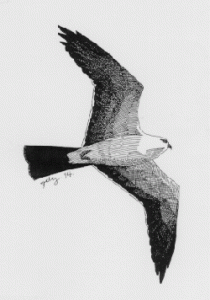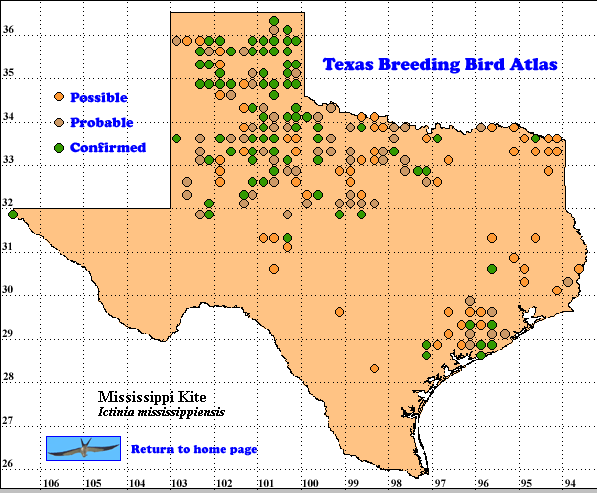Ictinia mississippiensis
The Mississippi Kite is a fairly common breeding raptor throughout its somewhat restricted range. It breeds across the southern states from Florida as far west as Arizona and New Mexico (A.O.U. 1983). It reaches its maximum abundance in the central states of Texas, Oklahoma, and Louisiana (Price et al. 1995). During migration this kite undertakes a long migration as it spends the winter months in South America. However, Oberholser (1974) listed five scattered records of individuals wintering in southern Texas.
The Mississippi Kite is prone to wandering with individuals regularly turning up in such widely scattered locations as South Dakota (Berkey 1987) and Massachusetts (Mactavish 1987). It feeds extensively on large insects including grasshoppers, cicadas, beetles, and dragonflies (Oberholser 1974) but will also eat bats, lizards, and mice (Bent 1937, Ehrlich 1988, Glinski & Ohmart 1983). When cicadas are abundant (as they were in the vicinity of Lubbock in 1991) they make up the bulk of the diet (Bolen & Flores 1993).
DISTRIBUTION: In Texas the Mississippi Kite is mainly restricted to the north-central portion of the state during the breeding season. It is fairly common in this area and it was confirmed as a breeder regularly in the Panhandle. Away from this area, there were several records (including a number of confirmed reports) in the southeast, centered around Matagorda County (28095), and scattered records throughout the northeast. There was even one confirmed record in the extreme northeast of the state at latilong 33094, where Oberholser (1974) did not report any breeding. Otherwise its overall distribution is similar to that reported by Oberholser (1974) except for the fact that he listed scattered summer reports along the middle Rio Grande, where TBBAP volunteers were unable to find the bird. Both Oberholser (1974) and the TBBAP registered one breeding record in the vicinity of El Paso (31106), far to the west of any other records in the state. Away from these areas it has to be considered a rare, local bird in Texas. Most TBBAP records away from the areas discussed above were listed as possible and, in all likelihood, did not represent breeding individuals.
SEASONAL OCCURRENCE: The Mississippi Kite proved to be a fairly easy species to confirm with a 33% confirmation rate among the 310 records obtained by the TBBAP. Only 10 of the records were of active nests with eggs or young.
The breeding season is protracted, extending from April to August (Oberholser 1974, James & Neal 1986). This bird is single brooded but the time from egg laying to fledging takes almost three months and the young require parental care for some weeks afterwards (Baicich & Harrison 1997, Glinski & Ohmart 1983). All of the nests with young recorded by atlas volunteers were found between 2 July and 2 August which is within the range of dates reported by Oberholser (1974) who listed egg dates from 3 May to 12 July and young in the nest from 23 May to 27 August.
BREEDING HABITAT: The Mississippi Kite generally nests near water and prefers open woodlands, prairies with trees, and similar
habitats (A.O.U. 1983, Ehrlich 1988). Many of the records included in the Cornell University Nest Record Card Program are from riparian areas. It sometimes nests semi-colonially (Baicich & Harrison 1997, Bent 1937, Oberholser 1974). Oberholser (1974) listed a colony of about 100 nests on 16 ha (40 acres). It also migrates in flocks, sometimes in association with other raptors (Howell & Webb 1995). The Mississippi Kite can also tolerate urban environments and is common in some cities including Garden City, Kansas and Lubbock, Texas (Bolen & Flores 1993).
This kite is known to nest very high in trees, sometimes in excess of 30 m (100 ft) (Baicich & Harrison 1997, Bent 1937). However, the Cornell University Nest Record Card Program has several records of nests between 2 – 8m (6 – 25 ft) high in Texas.
STATUS: Unlike many neotropical migrants, the Mississippi Kite’s population has remained stable or increased slightly in Texas and adjoining states in the past 30 years, according to BBS data (Sauer et al. 1996). It had declined considerably in the late 19th and early 20th centuries, especially in the eastern half of its range, but it began to return to its former numbers by about 1950 (Oberholser 1974, Parker & Ogden 1979).
It is interesting to note that this bird has expanded its range westward considerably during this century. According to Parker & Ogden (1979) the western limit of its breeding range has expanded by over 700km (430 miles) from Texas and northeastern Kansas to Arizona and New Mexico. It has undoubtedly benefitted by the planting of shelterbelts on the prairies which provide suitable nest sites in areas of high prey abundance. However, it may be adversely affected by exotic species, such as salt-cedar, invading riparian areas and driving out cottonwoods which are heavily used by these birds (Glinski & Ohmart 1983).
The Mississippi Kite’s Texas population does not appear to be limited by factors present on its breeding grounds. However, its long term success depends equally on the continued availability of suitable habitat on its wintering grounds in South America and along its migration path through middle America.
Text by David E. Fantina (ca. 1998)
Literature Cited
American Ornithologists Union. 1983. Checklist of North American birds, 6thed. Washington, D.C.
Baicich, P.J. and C.O. Harrison. 1997. A guide to the nests, eggs, and nestlings of North American birds. Academic Press, San Diego, CA.
Bent, A .C. 1937. Life histories of North American birds of prey. U.S. Nat. Mus. Bull., 167. Washington, D.C.
Berkey, G. B. 1987. Northern great plains region. Am Birds 44: 1453.
Bolen, E.G. and D. Flores. 1993. The Mississippi Kite. University of Texas Press, Austin.
Ehrlich, P.R., D.S. Dobkin, and D. Wheye. 1988. The birder’s handbook. Simon & Schuster, New York.
Glinski, R .L. and R .D. Ohmart. 1983. Breeding ecology of the Mississippi Kite in Arizona. Condor 85: 200-207.
Howell, S. N .G. and S. Webb. 1995. A guide to the birds of Mexico and northern Central America. Oxford University Press, New York.
James, D. A. and J. C. Neal. 1986. Arkansas birds. University of Arkansas Press, Fayettville.
Mactavish, B. 1987. Northeastern maritime region. Am. Birds 41: 402.
Oerholser, H.C. 1974. The bird life of Texas. University of Texas Press, Austin.
Parker, J. W. and J. C. Ogden. 1979. The recent history and status of the Mississippi Kite. Am. Birds 33: 119-129.
Price, J., S. Droege, and A. Price. 1995. The summer atlas of North American birds. Academic Press, San Diego, CA.
Sauer, J. R., B. G. Peterjohn, S. Schwartz, and J. E. Hines. 1996. The North American Breeding Bird Survey Home Page. Version 95.1. Patuxent Wildlife Research Center, Laurel, MD. (Accessed 25 August, 1998).

